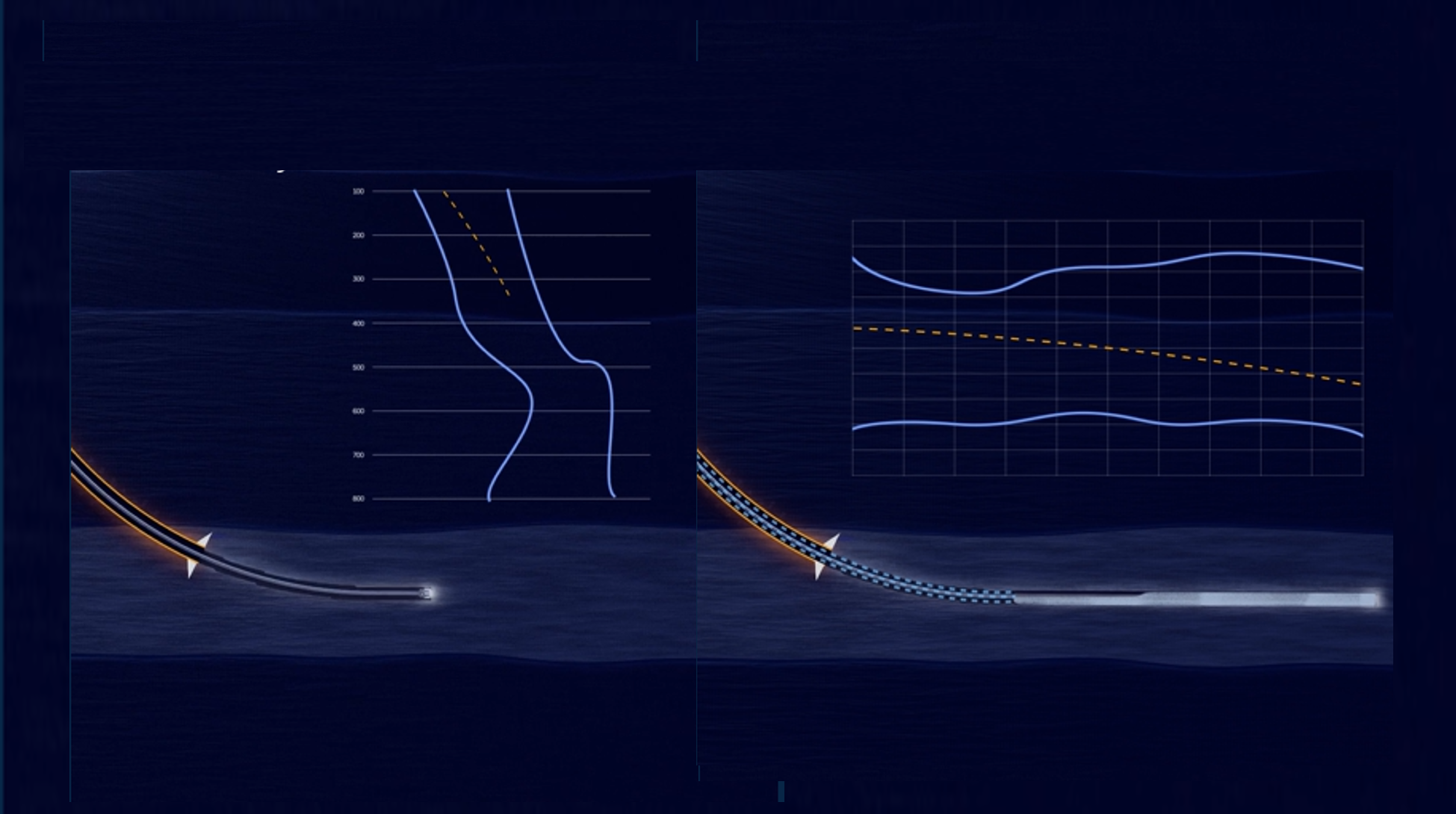9 Criteria to Consider Before Selecting Technology for Kick & Loss Detection
This guide is carefully designed for operations managers and drilling engineers, shedding light on crucial factors that greatly affect the efficiency, safety, and cost-effectiveness of drilling projects.
After working internationally for a decade, he has returned to Norway moving from an operational role to focusing more on technical sales.
Sneak peak of what's ahead:
-
Learn what conventional kick & loss detection technology is and it works.
-
Get to know the EC-Monitor™ and its benefits and drawbacks.
-
Understand how these technologies function, their benefits, limitations, and how they align with your goals.
Frequently Asked Questions
To help you get even more value from this guide, these FAQs highlight the questions we most often receive from drilling professionals. They provide quick clarifications on key points so you can apply the insights more effectively to your own operations.
Executive Summary
Welcome to a comprehensive guide designed to enlighten you about the critical aspects of kick & loss detection technology in drilling operations. As an operations manager or drilling engineer, understanding these technologies' nuances is pivotal in optimizing your drilling operations' efficiency, safety, and cost-effectiveness.
In this eBook, we will delve into a detailed comparison between conventional kick & loss detection technologies and Enhanced Drilling's EC-Monitor™. By the end of this guide, you will gain a thorough understanding of how these technologies function, their benefits, drawbacks, and most importantly, how they align with your operational goals.

How conventional kick & loss detection technology works
Basic sensor and measurement system
Conventional kick & loss detection in drilling operations primarily relies on a combination of basic sensors and manual measurement
systems. These systems typically include pit level sensors and flow paddles, which monitor the level and flow rate of drilling fluids.
The pit level sensors are used to detect significant changes in fluid volume in the reserve pits, which can indicate a kick (an influx of formation fluid into the wellbore) or loss (fluids being lost to the formation).
Manual trip sheets and monitoring
Drilling crews use manual trip sheets to track the amount of drilling fluid going in and out of the well. During tripping operations (when the drill string is being inserted or removed from the wellbore), these sheets are filled out manually to monitor fluid levels. This process
requires close attention from the mud loggers and drillers, who must constantly monitor and record fluid levels and rates.
Flow rate measurement
Flow rate measurements are often conducted using Coriolis flowmeters or similar devices, especially when circulating drilling fluids. These meters provide data on the flow rate of the mud system but are typically effective only during circulation.e pressure in the surrounding rock formations.
Static flow checks
Static flow checks are conducted to verify the well is stable. This involves observing fluid levels over a period of time to detect any gain or loss. These checks are essential but are time-consuming.
Mud logging
A crucial component of conventional methods is mud logging, where specialists monitor drilling parameters, including gas levels, cuttings, and fluid properties. Mud loggers play a vital role in interpreting data and identifying potential kicks or losses based on changes in these parameters.
Additional reading: 8 Consequences of Late Kick Detection in Drilling Operations

How EC-Monitor™ works
Elimination of external effects
The system is designed to negate the impact of rig and slip-joint motion, providing highly accurate volume and flow measurements. This feature is crucial for the rapid detection of flow anomalies and reduces the time spent on flow-checking.
Inline trip-tank design
The EC-Monitor™ effectively functions as an inline trip-tank positioned above the telescopic joint. It is sized to absorb volume fluctuations caused by the telescopic joint motion.
Sensor utilization and compensation
Simple sensors measure the return flow fluctuations caused by the telescopic joint, and the EC- Monitor™ system compensates for these variations.
Centrifugal pump integration
A centrifugal pump transfers mud from
the inline trip-tank to the flowline, always maintaining full lines in the system, which eliminates the uncertainty of volume in the flowline.
Advanced algorithms for data processing
The system uses sophisticated algorithms to filter out sensor noise and process disturbances.
Flow spool placement and function
The flow spool, situated directly
in the riser string above the telescopic joint, absorbs volume changes associated with heave. These changes are accounted for in the EC-Monitor™ software.
Continuous volume monitoring
This setup allows for an uninterrupted
and accurate comparison of volume in versus volume out, facilitating dynamic and continuous flow monitoring across all well stages.
Check out: Non-Stop Well Monitoring: How to Improve it
Comparison
"Loss" refers to the situation where drilling fluids, commonly known as mud, are lost into the formation because the pressure in the well exceeds the fracture pressure of the formation. This phenomenon, often termed as "lost circulation," is a significant challenge in drilling operations.
1. Accuracy and reliability
Conventional technology: Traditional kick & loss detection technologies in the drilling industry rely on a combination of sensors, manual readings, and driller's experience. While they have been the backbone of drilling operations for decades, their accuracy and reliability are subject to several limitations.
Firstly, these methods are prone to human error, as they often require manual data interpretation, which can vary based on the individual's skill and experience. Furthermore, conventional systems struggle with rig motion effects, leading to inaccurate readings and potential misjudgments in critical situations. For instance, in high-sea conditions, rig movement can significantly alter fluid level readings in pits or tanks, which are crucial for detecting kicks or losses. This lack of precision can lead to delayed responses to well control issues, posing safety risks and operational inefficiencies.
EC-Monitor™: On the other hand, Enhanced Drilling's EC-Monitor™ is designed to address these accuracy and reliability concerns head-on. By integrating advanced sensors and compensating algorithms, the EC-Monitor™ effectively eliminates inaccuracies caused by rig motion.
The system is engineered to provide real-time data which is not only precise but also consistent, regardless of external environmental factors. This is achieved through its unique design – an inline trip-tank system for direct monitoring on the well, and absorption of volume fluctuations caused by telescopic joint motion, ensuring stable measurements. The use of centrifugal pumps to maintain consistent flow and advanced software algorithms to filter out noise and disturbances further enhances its reliability.
This technological sophistication translates to a significant reduction in human interpretation errors and rapid detection of anomalies, ensuring operational safety and efficiency. The system has been proven to detect kick & loss 7-10 minutes earlier than conventional technology. In high-stakes drilling environments, where accuracy can mean the difference between a successful operation and a costly mishap, the EC-Monitor™ provides a much-needed layer of precision and reliability.
2. Real time monitoring capability
Conventional Technology: Conventional kick & loss detection methods are often hampered by their limited real-time monitoring capabilities. In many cases, these systems rely on periodic manual checks or readings that provide a snapshot of the well's status, rather than a continuous stream of data. This approach can result in gaps in monitoring, especially during non-circulating phases of drilling operations, leaving room for
undetected issues to escalate.
Additionally, the data from these methods is often reactive; it indicates a problem after it has occurred, rather than providing proactive monitoring that could prevent issues from developing.
EC-Monitor™: The system offers a comprehensive solution to these limitations with its continuous, real-time monitoring
capabilities. The system is designed to track flow throughout all stages of the well, not just during circulation. This means that any anomalies or changes in well conditions are detected instantaneously, allowing for immediate action.
The continuous monitoring is particularly advantageous during critical phases of drilling operations, such as tripping in and out of the hole, where traditional methods may fall short. By providing a constant stream of accurate data, the EC-Monitor™ enhances the ability to respond swiftly to kick & loss events
Additionally, the EC-Monitor™ introduces several other significant benefits enhancing its real-time monitoring capabilities:
- No additional personnel required: The system operates autonomously, negating the need for extra staffing specifically for monitoring purposes.
- Independent operation from rig personnel: EC-Monitor™ functions without requiring active management or intervention from rig personnel during operations, streamlining workflow and reducing workload.
- Easy, continuous feedback: The system offers continuous feedback on volume levels during tripping, facilitating faster and more efficient tripping operations with fewer interruptions.
- Automated audible alarm: An automated alarm system alerts the driller when set limits are exceeded, ensuring immediate attention to potential issues.
- Real-time trend monitoring: EC-Monitor™ enables the tracking of real-time trends, providing valuable insights into well conditions and aiding in informed decision-making.

3. Ease of installation and maintenance
Conventional Technology: The installation and maintenance of conventional kick & loss detection systems are generally
straightforward, owing to their simpler technology and widespread use in the industry. These systems typically require
standard equipment that most drilling rigs are already equipped with, making the installation process relatively uncomplicated.
However, the maintenance aspect can be more demanding. Regular checks and calibrations are necessary to ensure the sensors and measurement devices are functioning correctly. This maintenance often requires on-site personnel and can be time-consuming, especially if the equipment is older or has been subjected to harsh drilling conditions
EC-Monitor™: The EC-Monitor™, while more complex in its technology, is designed with ease of maintenance in mind. The installation of the system, though more sophisticated than conventional technologies, is a one-time process that only adds 15 minutes to the operational time,, yet brings long-term benefits. It integrates into the existing drilling infrastructure, with specific attention to minimizing operational downtime.
The system's components are built to withstand the rigors of drilling environments, requiring less frequent maintenance than traditional systems. Additionally, software updates and troubleshooting can often be conducted remotely, reducing the need for on-site maintenance activities. This not only saves time but also reduces the dependency on manual labor, leading to cost savings in the long run.
The ability to maintain optimal functionality with minimal intervention makes EC-Monitor™ an attractive option for operations seeking to streamline their maintenance processes and focus on uninterrupted drilling operations.
4. Cost-effectiveness
Conventional technology: Conventional kick & loss detection technologies, while typically having lower initial setup and equipment costs, may lead to higher operational expenses in the long term. These costs can be attributed to several factors: the need for constant manual monitoring, regular maintenance and calibration of equipment, and potential downtime due to inaccuracies or delayed responses to well control issues.
Additionally, these systems might require frequent updates or replacements to keep up with evolving safety standards and
operational demands, contributing to their total cost of ownership. While initially budget-friendly, these hidden costs can
accumulate, impacting the overall cost-effectiveness of the operation.
EC-Monitor™: Enhanced Drilling's EC-Monitor™, although associated with a higher initial investment, offers significant long-term cost savings. The advanced technology and automation of the EC-Monitor™ reduce the need for extensive manual labor and continuous monitoring, thereby lowering operational costs. The system's precision and real-time monitoring capabilities also mean quicker response times to potential issues, reducing the likelihood of costly well control events and non-productive time.
Additionally, its low-maintenance design and remote troubleshooting capabilities further diminish ongoing operational expenses. This represents a cost-effective solution when considering the total life cycle costs of drilling operations. It's an investment that not only enhances your operational efficiency and safety but also pays dividends in the form of reduced long-term expenses.
5. Adaptability to various drilling environments
6. Personnel training and cognitive load
readings. This process can be cognitively demanding, as it requires constant vigilance and decision-making, often under high-pressure conditions. The cognitive load is further increased by the need to manually log data and respond to potential well control issues based on this data, which can lead to fatigue and increased risk of human error.
and automatic alerts is a deterministic system allowing drillers to focus on broader operational aspects rather than constant data interpretation. This reduction in cognitive load can lead to a safer work environment, as operators are less likely to experience
fatigue or overlook critical issues. Furthermore, the automated nature of the system fosters a more efficient operational workflow, enabling personnel to address more complex tasks or respond more effectively to drilling challenges. This shift not only enhances the overall safety of drilling operations but also contributes to a more skilled and focused workforce.
7. Safety and environmental impact
Conventional technology: Traditional kick & loss detection technologies, while effective in many scenarios, can sometimes lag in responding to well control issues due to their reliance on manual monitoring and interpretation. This delay can lead to larger influxes in the event of a kick, potentially escalating into losing the well or in the most extreme cases blowouts.
Moreover, the accuracy of these systems can be compromised in challenging environments, increasing the risk of undetected kicks and losses. The environmental impact of such incidents can be significant, leading to the potential contamination of natural resources and extensive cleanup operations.
EC-Monitor™: Its ability to rapidly detect and alert personnel to kicks and losses significantly minimizes the risk of well loss, blowouts and other hazardous well control events. This prompt detection limits the size of any influx, thereby reducing the time and complexity of remedial actions, and, importantly, lessening the likelihood of formation damage and environmental harm. The system's accuracy in challenging conditions further ensures that environmental risks are minimized. By providing a more controlled drilling you can not only prioritize the safety of your operation
and your personnel, but also demonstrate a commitment to environmental stewardship, aligning with the growing industry focus on sustainable practices.
8. Integration with existing systems
Conventional technology: Conventional kick & loss detection systems have the advantage of being easily integrated into most existing drilling setups, given their long-standing use in the industry. They typically require standard equipment and processes, which are familiar to drilling personnel. This familiarity facilitates easier integration and fewer complications during implementation. However, these systems may lack the advanced features and efficiencies brought by newer technologies, potentially limiting their effectiveness in more complex drilling operations.
EC-Monitor™: The integration of EC-Monitor™ into existing drilling systems can significantly enhance the overall efficiency and safety of operations. The initial integration process may require some adjustments and technical expertise, however, once integrated, the EC-Monitor™ seamlessly works with other components of the drilling operation, providing enhanced data accuracy and real-time monitoring capabilities. The integration of such advanced technology may necessitate some initial training and adaptation but ultimately leads to a more sophisticated, efficient, and safer drilling operation.
9. Scalability and future-proofing

EC-Monitor™ vs. Conventional methods
After evaluating the key criteria for kick & loss detection technology, it's important to delve deeper into specific operational aspects where the EC-Monitor™ distinctly differs from conventional methods. This section aims to shed light on how these differences impact daily drilling operations.
1. Eliminates effect of rig motion
EC-Monitor™: Effectively nullifies the impact of rig motion on measurements, leading to more accurate data.
Conventional Methods: Often struggle with accuracy due to rig movements, causing erroneous readings and necessitating manual adjustments and interpretations.
2. Continuous flow monitoring during all well stages
EC-Monitor™: Offers real-time flow monitoring throughout all stages of the well, ensuring immediate detection of abnormalities. Continuously flow checks reducing need to perform static flow check.
Conventional Methods: Typically have intermittent monitoring, particularly during non-circulating phases, leading to potential delays in issue detection. Static flow checks consume an average of 3+ days per rig year.
3. Accurately show volume stability
EC-Monitor™: Provides precise and reliable data on well volume, facilitating informed decision-making.
Conventional Methods: May not always accurately reflect volume or flow, especially in transition from dynamic to static circulation scenarios.
4. Barrel in versus barrel out measurement
EC-Monitor™: Accurately measures the volume of fluid entering and exiting the well, crucial for kick & loss detection.
Conventional Methods: Rely on indirect methods of measuring fluid volumes, which can be less precise.
5. Quickly alerting user and systems to kick & loss events
EC-Monitor™: Rapidly detects and alerts personnel to kick & loss events, minimizing reaction time.
Conventional Methods: Delays in detection and human interpretation can lead to slower response.
6. Tighter alarm parameters remove the need for human interpretation
EC-Monitor™: Eliminates uncertainty factors such as heave and mud in flowline and uses automated alarms with tight parameters to reduce reliance on human judgment.
Conventional Methods: Heavily depend on drillers' interpretation of data.
7. Reduces drillers cognitive load
EC-Monitor™: Deterministic system that does not reply on user
interpretation. Automates many monitoring tasks, allowing drillers
to focus on other critical operational aspects.
Conventional Methods: Place a significant cognitive burden on
drillers due to constant data interpretation and decision-making.
8. Time saving
EC-Monitor™: Streamlines processes, reducing the time spent on monitoring and data interpretation.
Conventional Methods: More time-consuming due to manual processes and the need for static flow-checks
9. Step towards automated well control
EC-Monitor™: Represents a progression towards fully automated well control, enhancing operational efficiency and safety.
Conventional Methods: Largely manual, requiring more human intervention, less conducive to automation.
In summary, the EC-Monitor™ system offers significant advancements in accuracy, efficiency, and automation compared to conventional methods. These features not only enhance operational safety and effectiveness but also pave the way for more automated and less labor-intensive drilling operations.
Check out this webinar where you will learn more about the EC-Monitor™ and its benefits.

Additional benefits EC-Monitor™ can provide for your drilling operations
In this section, we explore and summarize the numerous operational advantages that you can gain by utilizing the EC-monitor™ system.
1. Reduced connection time
Benefit: Eliminates the need for waiting on no-flow conditions during connections, leading to a more streamlined process and time savings.
2. Reduced flow check time
Benefit: With no need for no-flow waiting and static checks (typically 10 minutes), flow checking becomes much quicker, enhancing operational efficiency.
3. Faster diverter function tests
Benefit: The EC-Monitor™ enables quicker testing of diverter functions, contributing to reduced downtime and increased safety.
4. No need to Pull Out of Hole (POOH) with Trip Tank pump off
Benefit: Simplifies operations by eliminating the need to lower fluid levels when pulling out of the hole, thus saving time, and reducing complexity.
5. Extremely high Fidelity in flow rate changes
Benefit: Offers precise detection of even minor changes in flow rates, leading to quicker responses to potential well control issues.
6. U-tube effect detection
Benefit: Capable of identifying the U-tube effect, providing valuable insights into well conditions.
7. Additional hole monitoring parameter with pressure sensor
Benefit: The inclusion of a pressure sensor in the riser adds an extra layer of monitoring, conducted directly on the well.
8. Enhanced view of Gain/Loss during mud weight changes
Benefit: Provides better insights and control when changing Mud Weight (MW), crucial for maintaining well stability.
9. Verification of Barite/Chemical calculations
Benefit: With no need for no-flow waiting and static checks (typically 10 minutes), flow checking becomes much quicker, enhancing operational efficiency.
10. Compatibility with Surface Back Pressure (SBP) Manage Pressure Drilling (MPD) Systems
Benefit: The system's compatibility with SBP MPD systems broadens its application range, making it a versatile tool for various drilling scenarios.
11. Increased fidelity on Rotating Control Device (RCD) sealing element wear
Benefit: Enhances the monitoring of RCD sealing elements, providing insights into wear and tear, which can inform maintenance
and replacement schedules. More accurate measurement of leakage rates, both when the RCD is latched and unlatched.
Takeaway
In conclusion, while conventional kick & loss detection technologies have served the industry well, the EC-Monitor™ presents a leap forward in terms of the accuracy, safety, efficiency, and adaptability it can provide for you.
We encourage you to consider how you can enhance your own operations, leading to safer, more efficient, and cost-effective drilling. As the industry evolves, staying ahead with cutting-edge technology will be instrumental in maintaining operational excellence.
Explore the benefits of EC-Monitor™ for your drilling operations. Reach out to our team for more information on how this technology can enhance efficiency.
Want more information?
Whether you're curious about MPD solutions, want tailored advice, or simply have questions - I'm here to help.
Fill out the form and I'll get back to you.





